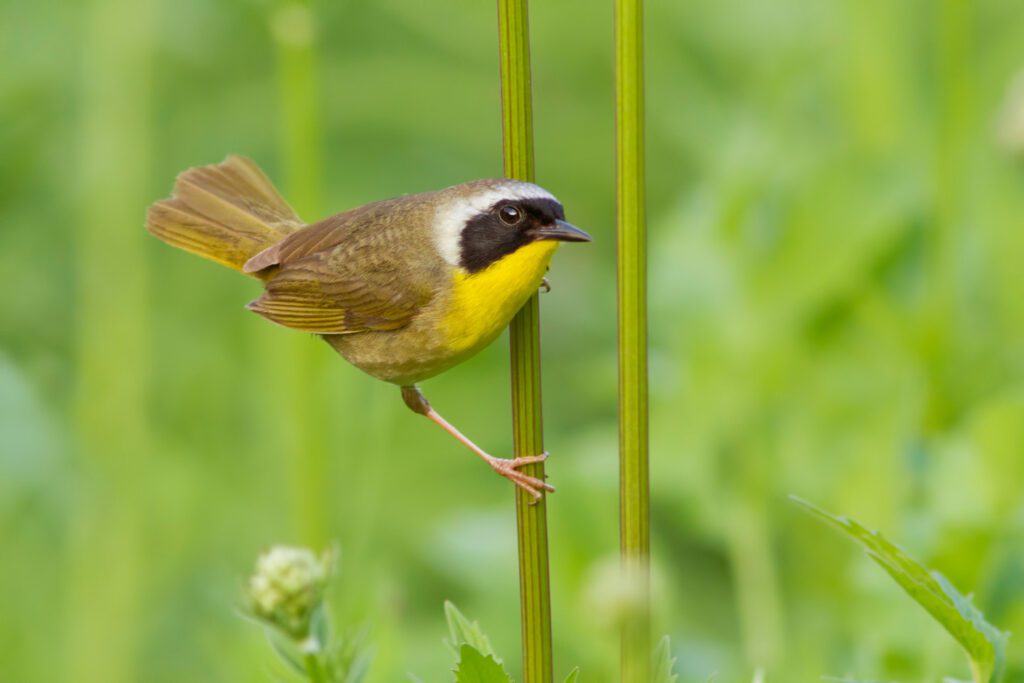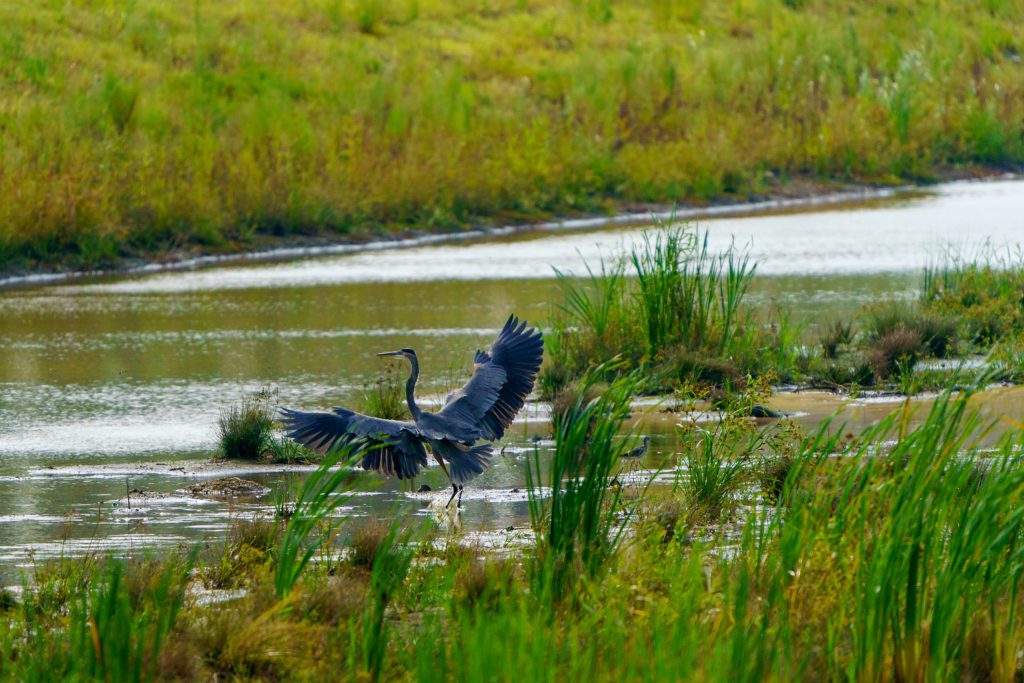Environmental Focus
Camp Hall is committed to maintaining an environment that is authentic to the natural habitat of coastal South Carolina. 28% of the whole site will be preserved land devoted to natural growth, wildlife habitats, and features developed to maintain and improve a healthy ecosystem.
Utilizing a variety of innovative solutions such as replacing existing non-native Loblolly pines with native species, incorporating bioswales in stormwater treatment, and providing pollinator habitats, Camp Hall will support local ecosystems.
Camp Hall’s Commitment:
- Restoration of approximately 365 acres of wetlands impacted by years of intensive tree farming.
- Permanent protection of approximately 2650+ acres of land, including approximately 1,265 acres of freshwater wetlands
- Restoration of wildlife habitat for a substantial number of native South Carolina species
- Developing and maintaining a “Pollinator Pathway” for birds, bees, and butterflies
- Developing a 15+ miles multi-use trail system to benefit both Camp Hall and the larger community by providing a place for recreation and engagement with nature
- By using rainwater harvesting, car charging stations, and solar panels in select locations, Camp Hall will demonstrate its commitment to sustainable building strategies.

Award-Winning
Environmental Design
The Department of Health and Environmental Control (DHEC) of South Carolina recognized Camp Hall Commerce Park with its prestigious Community Star award.
Restoration
Wetlands
Camp Hall made the commitment to preserve and restore the local environment and natural resources. That commitment includes returning the property to its native condition, erasing logging and other industrial impacts to wetlands, creating additional wetlands, reestablishing the headwaters of Timothy Creek, and improving critical areas beyond the original state.
To restore native tree species, Camp Hall planted more than 80,000 hardwood seedlings and trees in 2021, with plans to continue restoration as the trees mature. Natural regrowth of native grasses and plants is also occurring to create a diverse, emergent wetland.
Logging
After several decades in which logging has had a negative impact on the environment, Camp Hall has committed to restoring the local environment and returning the property to its native condition, while also creating additional wetlands.
In working to restore the property’s native condition, Camp Hall is committed to planting nearly 250,000 seedlings as part of the 500-acre wetland mitigation and restoration project. That project is crucial as the wetlands provide important habitat and sources of food for the animals at Camp Hall.
Wildlife

Common Gallinule
Seasons Present – Year Round
Common gallinule are medium-sized marsh birds with long legs and toes. They are mostly charcoal gray with a white stripe down their sides and white outer tail feathers. They reside in freshwater or brackish marshes, and lakes with a mix of submerged, floating, and emergent vegetation and open water.

Wood Duck
Seasons Present – Year Round
Wood ducks have a unique shape among ducks – a boxy, crested head, a thin neck, and a long tail. In good light, males have a glossy green head cut with white stripes, a chestnut breast and buffy sides. In low or harsh light, they’ll look dark overall with paler sides. Females are gray-brown with white-speckled breast. Look for Wood Ducks in wooded swamps, marshes, streams, beaver ponds, and small lakes. They stick to wet areas with trees or extensive cattails.

White Ibis
Seasons Present – Post-Breeding. Fewer in the Colder Season
White ibises are large wading birds with football-shaped bodies. They have long legs and a long neck that they hold out straight in flight. This ibis is almost entirely white, save for the black-tipped wings and brilliant reddish pink legs and bill. Juveniles (fall through winter) are brown above and white below with a streaky brown neck. White Ibises are wetland birds. They live in freshwater marshes, coastal estuaries, mangroves, flooded pastures, mudflats, and swamps.

Great Blue Heron
Seasons Present – Year Round
Great blue heron are the largest of the North American herons with long legs, a sinuous neck, and thick, dagger-like bill. Great blue herons appear blue-gray from a distance, with a wide black stripe over the eye. In flight, the upper side of the wing is two-toned: pale on the forewing and darker on the flight feathers. When hunting great blue herons wade slowly or stand statue-like, stalking fish and other prey in shallow water or open fields. Watch for the lightning-fast thrust of the neck and head as they stab their prey with their strong bills.

Green Heron
Seasons Present – Breeding
Green heron, compared with most herons, are short and stocky, with relatively short legs and thick necks that are often drawn up against their bodies. From a distance, green herons look dark. In better light, they are deep green in the back with a rich chestnut breast and neck. They stand motionless at the water’s edge as they hunt for fish and amphibians. Green herons live around wooded ponds, marshes, rivers, reservoirs and estuaries.

Eastern Kingbird
Seasons Present – Breeding
Eastern kingbird is a sturdy, medium-sized songbird with a large head, upright posture, square-tipped tail, and a relatively short, straight bill. They are blackish above and white below. The head is a darker black than the wings and back, and the black tail has a conspicuous white tip. Eastern kingbirds often perch in the open atop trees or along utility lines or fences. They breed in open habitats such as yards, fields, pastures, grasslands, or wetlands, and are especially abundant in open places along forest edges or water.

Eastern Phoebe
Seasons Present – Nonbreeding
Eastern phoebe is a plump songbird with a medium-length tail. It appears large-headed for a bird of its size. The Eastern phoebe is brownish-gray above and off-white below, with a dusky wash to the sides of the breast. The head is typically the darkest part of the upperparts. They generally perch low in trees or on fence lines. Phoebes are very active, making short flights to capture insects and very often returning to the same perch. These birds favor open woods such as yards, parks, woodlands, and woodland edges.

Belted Kingfisher
Seasons Present – Year Round
Belted kingfisher is a stocky, large-headed bird with a shaggy crest on the top and back of the head, and a straight, thick, pointed bill. Their legs are short and their tails are medium length and square tipped. These kingfishers are blue-gray above with fine, white spotting on the wings and tail. The underparts are white with a broad, blue breast band. Belted kingfishers spend much of their time perched alone along the edges of streams, lakes and estuaries, searching for small fish. They also fly quickly up and down rivers and shorelines giving loud rattling calls. Kingfishers live near streams, rivers, ponds, lakes, and estuaries.

Red-Winged Blackbird
Seasons Present – Year Round
Red-winged blackbirds are stocky and broad shouldered, with a slender, conical bill and a medium-length tail. They often show a hump-backed silhouette while perched. Males are an even glossy black with red and yellow shoulder badges. Females are crisply streaked and dark brownish, pale on the breast and often show a whitish eyebrow. Look for Red-winged blackbirds in fresh and saltwater marshes, along watercourses, water hazards on golf courses, and wet roadsides, as well as drier meadows and old fields.

Common Yellowthroat
Seasons Present – Year Round
Common yellowthroats are small songbirds with chunky, rounded heads and medium-length, slightly rounded tails. Adult males are bright yellow below, with a sharp black face mask and olive upper parts. A thin whitish line sets off the black mask from the head and neck. Females are a plain olive brown, usually with yellow lightening the throat and under the tail. Common yellowthroats spend much of their time skulking low to the ground in dense thickets and fields, searching for small insects and spiders. Yellowthroats live in open areas with thick, low vegetation, ranging from marsh to grassland to open pine forest.

Snowy Egret
Seasons Present – Breeding
Snowy egrets are medium-sized herons with long, thin legs and long, slender bills. Their long, thin neck sets the small head well away from the body. Adult snowy egrets are all white with a black bill, black legs and yellow feet. They have a patch of yellow skin at the base of the bill. Snowy egrets wade in shallow water to spear fish and other small aquatic animals. They are most common along the coast, though they do breed occasionally in inland wetlands.

Great Egret
Seasons Present – Year Round
Great egrets are tall, long-legged wading birds with long, S-curved necks and long, dagger-like bills. In flight, the long neck is tucked in and the legs extend far beyond the tip of the short tail. All feathers on great egrets are white. Their bills are yellowish-orange, and the legs are black. They wade in shallow water to hunt fish, frogs and other small aquatic animals. They typically stand still and watch for unsuspecting prey to pass by. You will find great egrets in both freshwater and saltwater habitats.

Anhinga
Seasons Present – Breeding
Anhingas are large and slender waterbirds with long, fanlike tails that resemble a turkey’s tail. They have a long, S-shaped neck and a daggerlike bill. Adult male anhingas are black with silvery-to-white streaks on the back and wings. Females and immatures have a pale tan head, neck and breast. They swim with their bodies partly or mostly submerged and their long, snakelike neck held partially out of the water. Anhingas inhabit shallow freshwater lakes, ponds, and slow-moving streams with branches or logs near the water for drying and sunning themselves.

Canada Goose
Seasons Present – Year Round
Canada geese are large water birds with a long neck, large body, large webbed feet, and a wide, flat bill. They have a black head with white cheeks and chinstrap, black neck, tan breast and brown back. Canada geese feed by dabbling in the water or grazing in fields and large lawns. They are often seen in flight moving in pairs or flocks. They can be found just about anywhere near lakes, rivers, ponds, or other small or large bodies of water, and in yards, park lawns, and farm fields.

Wood Stork
Seasons Present – Non-Breeding
Wood storks are hefty wading birds with football-shaped bodies perched atop long legs. They have a long neck and a long, thick bill that is curved at the tip. Wood storks are entirely white, save for their black flight feathers and tail. The head is unfeathered and scaly looking. Wood storks frequently feed in groups with their heads down feeling for prey in open wetlands. They breed in fresh and brackish forested wetlands.

Killdeer
Seasons Present – Year Round
Killdeer have the characteristic large, round head, large eye and short bill of all plovers. They are especially slender and lanky, with a long, pointed tail and long wings. Killdeer are brownish-tan on top and white below. The white chest is barred with two black bands, and the brown face is marked with black and white patches. They spend their time walking along the ground or running ahead a few steps, stopping to look around, and running on again.

Painted Bunting
Seasons Present – Breeding
Painted buntings are medium-sized, finchlike birds with stubby, thick, seed-eating bills. Males are stunningly colored with blue heads, red underparts and green backs. Females and immatures are a uniform, bright yellow-green overall, with a pale eying. Painted buntings forage on the ground in dense cover, among grasses, or at seed feeders. They breed in dense brush, often adjacent to thick, grassy areas or woodland edges.

Blue Grosbeak
Seasons Present – Breeding
Blue grosbeak are a stocky songbird with a very large, triangular bill that seems to cover the entire front of its face, from throat to forehead. Adult males are deep, rich blue with a tiny black mask in front of the eyes, chestnut wingbars and a black-and-silver beak. Females are primarily rich cinnamon brown. Blue gosbreak are unobtrusive despite their bright colors, although in summer males frequently sing their pleasant, rich, warbling songs. They are characteristic species of old fields beginning to grow back into woodland.

Eastern Towhee
Seasons Present – Year Round
Eastern towhees are a kind of large sparrow. Look for their thick, triangular, seed-cracking bill as a tip-off they’re in the sparrow family. Males are striking: bold, sooty black above and on the breast, with warm rufous sides and white on the belly. Females have the same pattern but are rich brown where the males are black. Eastern towhees spend most of their time on the ground, scratching leaves using both feet at the same time, in a kind of backward hop.
Trail System

Info Coming Soon












